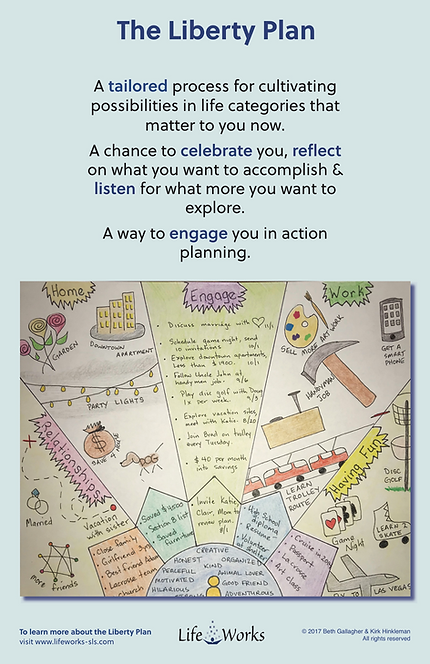CONSULTING
WORKSHOPS
INTENTIONAL
TEAMING

How it Works
Enter into a conversation with Beth and Kirk about how we develop teams in a way that is beneficial to everyone involved. Intentional Teaming, simply put, values each individual team member, utilizes their gifts, challenges their motivation and unifies the mission of the team. We’ll discover ways of sifting through the many layers of human connection and we’ll leave asking ourselves: “What is the next best question?” Intentional Teaming is a paradigm shift in the way we work with and care for each other. This training will combine many forms of learning including: presentation, exploration of tools from the book, group work, videos and discussion. Intentional Teaming presentations can be done in workshops of 1 or 2 days or can be done in a conference break-out presentation format.
LIBERTY PLAN

How it Works
In 2011, we, Kirk and Beth, were scheduled to do a person-centered plan for a young man that we were providing services for. A significant effort had been spent ahead of time with this person. We will call him Howard. We had spent several hours with Howard and his parents preparing him for the process that would take place. Howard’s family had invited numerous friends and extended family to come from the east coast to San Diego for the event. By numerous, we mean an additional 10-12 people that had made extensive effort to travel across the United States to be present. No pressure!
By the time we showed up on the day of the event to begin initial preparation for the plan, Howard was extremely agitated. He had barricaded himself in his room with the door shut and was yelling for everyone to get out of his apartment and leave him alone. There were two choices, we could leave OR we could think quickly and try hard to salvage the situation. What we knew at the time about Howard is that he was easily overwhelmed, sensitive to chaos, loves discussing history (the past), very reflective, thinks in structure and enjoys a quieter environment.
Quickly we put our heads together and thought if this is going to be successful what would we need to let die and what would we need to grow? How can we help Howard feel comfortable enough to engage in a successful process? We thought we might need to:
-
Brag about what is wonderful about Howard.
-
Reminisce about the great things in his life
-
Create sections to categorize the conversation
-
Create a barrier in the physical room between Howard and the other participants.
-
Define a plan to engage Howard and his loved ones in a plan towards success
Our plan worked! Howard was enthusiastic and completely engaged in the process from beginning to the end. The Liberty Plan was born out of the same values and ethics of the plans that we had been using for decades, PATH and MAPS. Both the process facilitation and the graphic facilitation guidelines still applied to our work. What we were cognizant of here is the need for customization. Howard’s story is the epitome of creation out of necessity. We strongly believe that each and every plan should be a work of blended ideas based on the vision of the person. The primary learning for both of us is: A plan can only be person-centered if the vision of the focal person is more imperative than the tool being used. The template is only that, a template. The real magic unfolds in the facilitation.
WHAT MORE
IS
POSSIBLE?

How it Works
Utilizing the What More Is Possible Framework developed and co-created by John O'Brien and Beth Mount, we walk through an iterative process designed to help ask important questions as a means to realizing, well, What More Is Possible?! When thinking of deep systems change, it becomes paramount that we step back and let go of archaic ways of implementing services, perhaps stuck viewing the world we live and work in with a disability-centered lens. What this framework brilliantly calls us to do is to shed previous notions of how folks with complex support needs interface with the world around them within the construct of the service system and begs us to ask simple, yet profound questions…questions that lead us to viewing people through a citizen-centered lens.
We'll partner, walk with and help guide individuals, teams and organizations through these spirals, asking questions such as: Asking more of self, Asking more of services, Asking more of community…all the while leading us to uncover Capacities, adjust supports, explore community, supporting connection and contribution while making alliances with citizens in the community. The ultimate goal is to achieve Membership for people…one person at a time.
The What More Is Possible workshops are intended to be of greater length, 2-3 days each session over several months as the intention of the process is to work closely with people over an iterative process, developing 'prototypes' as a means of learning together. We'll share stories together, form coaching circles and approach everything with a collaborative foundation. Join us for a journey together of letting go of the past and, as Otto Scharmer puts it "stepping into an emerging future."
